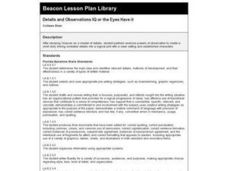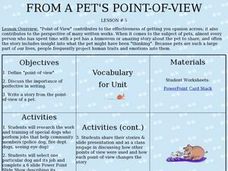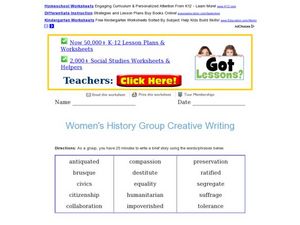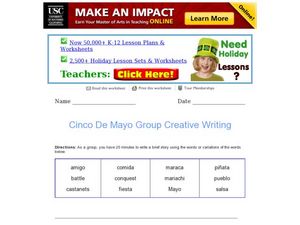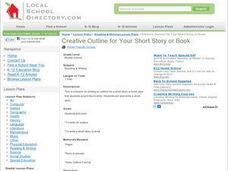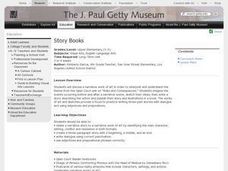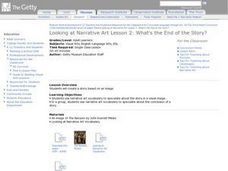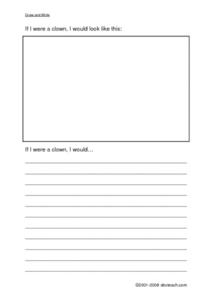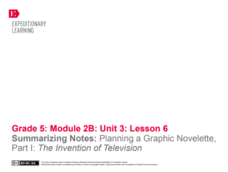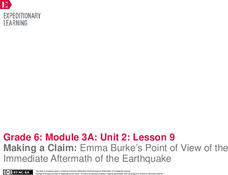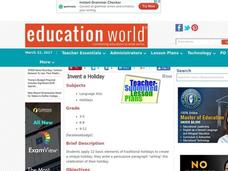Curated OER
You Are What You Wear
Students, after analyzing interactions between groups/societies, effects of causality/change over time, forms of imaginative writing and utilizing art media to conveying messages/meaning, examine the relationship between clothing and...
Curated OER
Details and Observations IQ or the Eyes Have it
Fourth graders study Chaucer as a master of details. Then, they create a short story linking unrelated details into a logical plot with a clear setting and established characters. This lesson has some excellent worksheets attached!
Curated OER
From a Pet's Point of View
Learners explore the concept of point of view. For this point of view lesson, students discuss the point of view of a pet and write an imaginative story. Learners then create a power point presetation for the class to...
Curated OER
Critical Thinking & Writing: Brainstorming
Have your young writers organize their thoughts before writing. They generate ideas through various brainstorming activities prior to writing a mock feature news story for USA Today. A series of USA Today articles debating the level of...
Curated OER
Women's History Group Creative Writing
In this women's history writing worksheet, students have 25 minutes to write a story using given phrases related to women's history.
Curated OER
Cinco De May Creative Writing
In this Cinco De Mayo worksheet, students work with a group, writing a creative story about the holiday, using words given in a word box. Worksheet contains links to additional activities.
Curated OER
Human Body Group Creative Writing
In this human body writing worksheet, students collaborate with classmates to write a group story. Students have 25 minutes to write the story; all 16 words in the box must be used.
Curated OER
Tell Me a Story
Tenth graders read short story, "The Storyteller" by Saki, and expand on concept of stories for students by reading and evaluating several popular students's stories as well as writing their own original students's stories.
Curated OER
Creative Outline for Your Short Story or Book
Middle schoolers discuss the information listed about how to make an outline for a short story or book. They then begin writing their short story and edit it and revise before turning it in to be graded.
Curated OER
Short Story Framework
The class gets creative after listening to a short story containing a definitive structure. They are required to think about character, relationship, and setting, while attempting to show rather than tell, in their writing. Dialogue,...
Curated OER
Story Books
Students discuss a narrative work of art, then write stories describing the action and publish their stories and illustrations in books.
Curated OER
Looking At Narrative Art Lesson 2: How Does The Story End?
Students use narrative art vocabulary to speculate about the story in a visual image. In a group, students use narrative art vocabulary to create a story with an ending. They view images imbedded in this lesson plan.
Curated OER
Creative Writing Idea Sheet
In this creative writing ideas worksheet, students create their own stories as they use the setting, character, and objects listed on the worksheet to fuel their ideas.
Curated OER
Writing and Podcasting
Students make a podcast of the stories they have written. In this writing lesson plan, students create creative writing stories based on pictures they receive and then put them into a podcast.
Curated OER
What Would You Look Like if You Were a Clown?
In this language arts worksheet, students write a creative story about what they might look like if they were a clown. Students are encouraged to use many descriptive words. Students then draw a picture to match their description.
Curated OER
I'm a Changed Pig
Introduce your class to fairy tales with this lesson. After reading the fractured fairy tale, "The Three Little Wolves and the Big Bad Pig," third, fourth, and fifth graders write a personal narrative as a response to the fairy tale....
Curated OER
Storytelling
Show young readers how to put some personality and voice into their storytelling with an in-depth assignment. Kids practice saying the same thing, such as counting from one to ten, in different tones and perspectives, and then work on...
Curated OER
The Popcorn Book
Pop, pop, pop! Can you hear the sound popcorn makes when it's being made? Start the day by reading The Popcorn Book. Youngsters will love stringing together popcorn necklaces and learning about popcorn. There are separate prompts and...
EngageNY
Summarizing Notes: Planning a Graphic Novelette Part 1: The Invention of Television
What's the story? Learners create the first of four storyboards about the invention of the television, incorporating narrative techniques and descriptive details. Next, they offer and receive feedback by participating in a peer critique...
EngageNY
Making a Claim: Emma Burke’s Point of View of the Immediate Aftermath of the Earthquake
Sharpen those pencils; it's time to write! Scholars begin writing the first body paragraph of their literary analysis essays. Additionally, pupils use graphic organizers to analyze a character's point of view from Laurence Yep's...
Curated OER
Invent a Holiday
Who wouldn't want to create their own holiday? Use the 12 elements of a holiday to have learners of all ages create their own holiday. These days, it seems like we make any excuse for a holiday! Consider having some fun with your kids...
Michigan State University
Create an Animal
Think beyond the animals and habitats we've already discovered and allow scholars to dream up their very own habitat and an animal that lives there. Class members present the new habitat and animal on a poster alongside an...
Film Education
The Jungle Book
Accompany a viewing of Disney's live-action feature film, The Jungle Book, with a packet equipped with several activities focused on story elements. Scholars discuss and complete diagrams and charts about the movie's characters, setting,...
National Council of Teachers of English
A Bear of a Poem: Composing and Performing Found Poetry
Scholars work collaboratively to compose a found poem from one of their favorite stories. With a finished product in hand, class members form a circle and perform their work for an audience by taking turns reciting one line till the poem...

